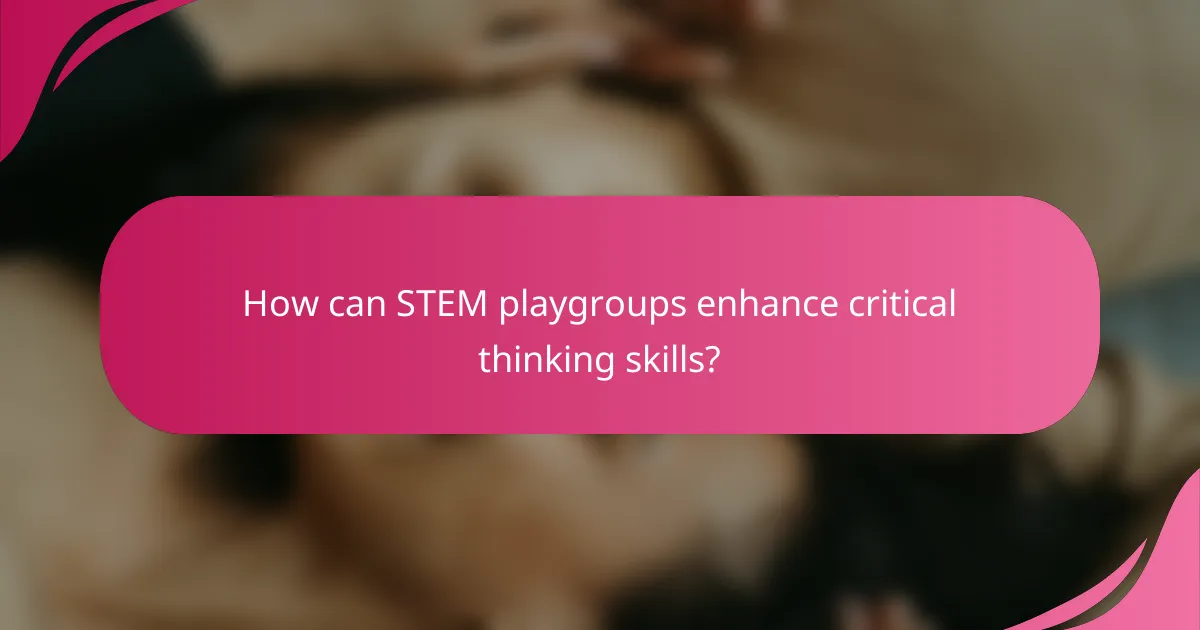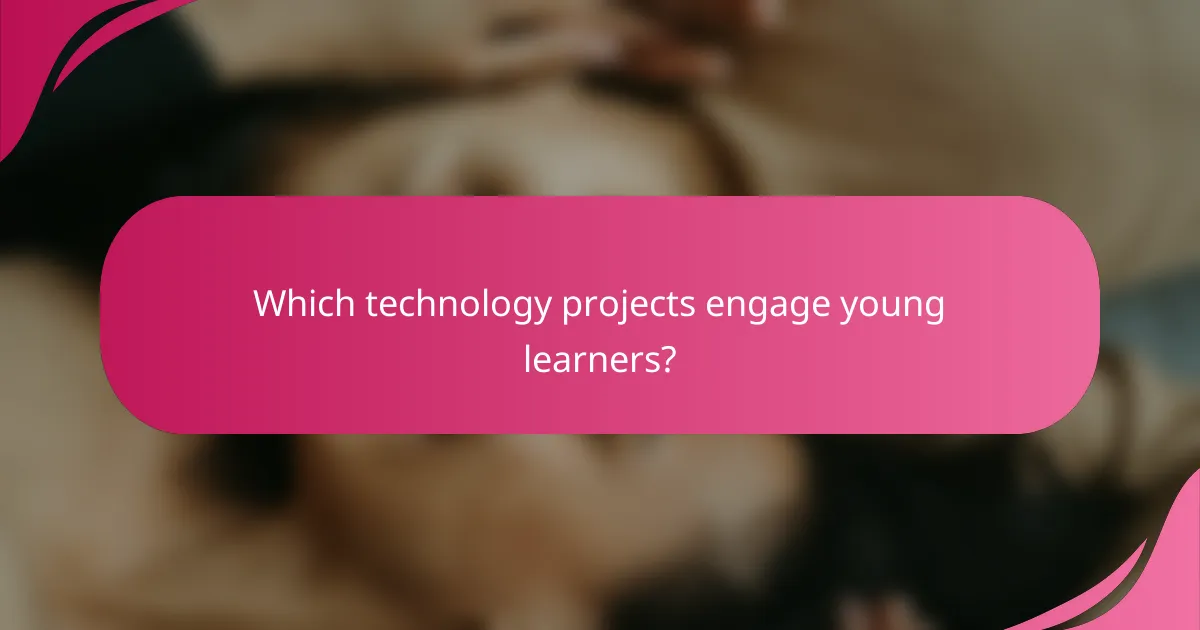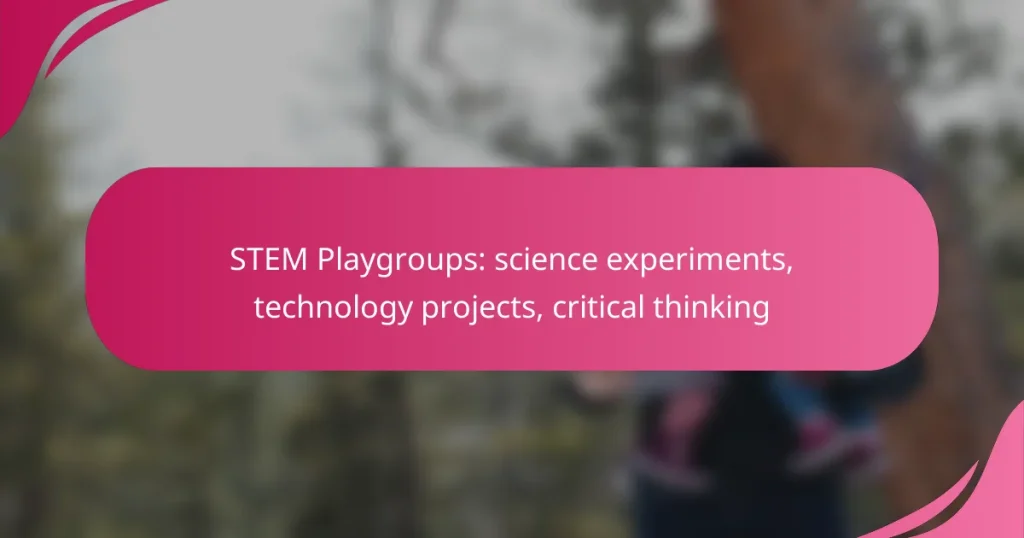STEM playgroups provide an engaging environment where children can explore science experiments, technology projects, and critical thinking activities. By participating in hands-on experiences, children develop essential skills such as inquiry, analysis, and collaborative problem-solving. These interactive sessions not only spark curiosity but also lay the foundation for a deeper understanding of scientific and technological concepts.

How can STEM playgroups enhance critical thinking skills?
STEM playgroups can significantly enhance critical thinking skills by engaging children in interactive learning experiences that promote inquiry and exploration. Through hands-on activities, they encourage participants to ask questions, analyze information, and develop solutions collaboratively.
Hands-on science experiments
Hands-on science experiments allow children to explore concepts in a tangible way, fostering curiosity and analytical thinking. Activities such as simple chemical reactions or building basic circuits can illustrate scientific principles while encouraging experimentation.
For example, a classic vinegar and baking soda reaction can teach children about chemical changes while they hypothesize and observe outcomes. Keeping experiments safe and age-appropriate is crucial, with many suitable for children as young as five.
Collaborative technology projects
Collaborative technology projects enable children to work together to solve problems using digital tools. Building a simple robot or creating a basic app can enhance teamwork and communication skills while introducing programming concepts.
Using platforms like Scratch or LEGO Mindstorms, children can learn coding basics and design principles. Encouraging group discussions about their design choices can further develop their critical thinking and reasoning abilities.
Problem-solving activities
Problem-solving activities challenge children to think critically and creatively. Puzzles, logic games, and engineering challenges can stimulate cognitive skills and promote resilience when faced with difficulties.
For instance, using everyday materials to build a bridge that can hold weight encourages children to think about design and structural integrity. Setting time limits can add a competitive element, motivating them to think quickly and effectively.
Real-world applications
Integrating real-world applications into STEM playgroups helps children understand the relevance of their learning. Discussing how engineering solutions address community issues or how technology impacts daily life can make concepts more relatable.
For example, exploring renewable energy sources can lead to discussions about sustainability and environmental responsibility. Encouraging children to brainstorm solutions for local challenges can enhance their critical thinking while fostering a sense of community involvement.

What types of science experiments are suitable for playgroups?
Playgroups can engage children with a variety of science experiments that are safe, simple, and educational. Suitable activities often involve hands-on experiences that stimulate curiosity and encourage critical thinking.
Simple chemical reactions
Simple chemical reactions are perfect for playgroups because they are visually exciting and easy to conduct. Common examples include baking soda and vinegar volcanoes or mixing cornstarch and water to create a non-Newtonian fluid.
When planning these experiments, ensure that all materials are non-toxic and safe for children. Always supervise the children closely and provide clear instructions to prevent any mishaps.
Physics with everyday materials
Physics experiments using everyday materials can help children grasp fundamental concepts like gravity and motion. Activities such as building a simple catapult with spoons and rubber bands or creating a marble run with cardboard tubes can illustrate these principles effectively.
Encourage children to experiment with different designs and observe the outcomes. This hands-on approach fosters problem-solving skills and critical thinking as they learn what works and what doesn’t.
Biology through nature exploration
Exploring biology through nature is an engaging way for children to learn about living organisms and ecosystems. Activities like collecting leaves, observing insects, or planting seeds can spark interest in the natural world.
When conducting these activities, guide children in making observations and asking questions about their findings. This encourages a sense of wonder and promotes scientific inquiry as they explore their environment.

Which technology projects engage young learners?
Technology projects that engage young learners often combine creativity with fundamental concepts in coding, electronics, and robotics. These projects not only captivate children’s interest but also foster critical thinking and problem-solving skills.
Basic coding with Scratch
Scratch is a user-friendly programming language designed specifically for children. It allows young learners to create interactive stories, games, and animations by snapping together code blocks, making it accessible even for beginners.
To start with Scratch, children can explore pre-made projects to understand how coding works. They can then modify these projects or create their own from scratch, encouraging experimentation and creativity.
Common pitfalls include overwhelming young learners with complex concepts too soon. Focus on simple projects that gradually introduce new coding ideas, ensuring a fun and engaging experience.
Building simple circuits
Building simple circuits is a hands-on way to teach young learners about electricity and electronics. Using basic components like batteries, wires, and light bulbs, children can create functioning circuits that illustrate how electrical systems work.
Start with a simple circuit project, such as lighting a bulb with a battery. As they gain confidence, introduce more complex projects, like using switches or sensors. This progression helps reinforce learning through practical application.
Safety is crucial; ensure children understand the importance of handling electrical components properly. Use low-voltage batteries to minimize risks and supervise their activities closely.
Robotics with LEGO Mindstorms
LEGO Mindstorms combines building with programming, allowing young learners to create and control robots. This platform encourages creativity while teaching engineering and coding principles through hands-on experience.
Begin with simple robot designs, guiding children through the assembly process. Once built, they can program their robots to perform tasks, such as moving or responding to sensors, which enhances their understanding of robotics.
Encourage collaboration by having children work in teams to solve challenges with their robots. This not only fosters teamwork but also helps them learn from each other’s ideas and approaches.

What are the benefits of STEM playgroups in urban areas?
STEM playgroups in urban areas provide children with essential skills in science, technology, engineering, and mathematics through hands-on activities. These groups foster critical thinking and creativity while making learning accessible and engaging in diverse environments.
Access to diverse resources
Urban areas often have a wealth of resources that can enhance STEM playgroups, such as local museums, science centers, and libraries. These facilities frequently offer workshops, materials, and expert guidance that can enrich the learning experience.
Additionally, partnerships with local businesses and universities can provide access to advanced technologies and tools. For example, children might use 3D printers or coding software that they wouldn’t typically encounter in a standard classroom setting.
Community engagement opportunities
STEM playgroups encourage community involvement by bringing together families, educators, and local organizations. This collaboration can lead to a stronger support network for children and their parents, fostering a sense of belonging and shared purpose.
Moreover, community events such as science fairs or technology showcases can be organized, allowing children to present their projects and discoveries. These events not only build confidence but also promote interest in STEM fields among peers and adults alike.

How can parents support STEM learning at home?
Parents can significantly enhance STEM learning at home by fostering an environment that encourages exploration and critical thinking. This can be achieved through engaging activities, providing resources, and actively participating in science-related events.
Encouraging curiosity through questions
Asking open-ended questions can stimulate children’s curiosity and promote critical thinking. Instead of simply providing answers, encourage kids to think about “why” and “how” things work. For example, if your child is curious about why the sky is blue, ask them to come up with their own explanations before discussing the scientific reasoning.
Make it a habit to integrate questions into daily activities. When cooking, ask about the changes happening to ingredients or why certain methods are used. This practice not only nurtures curiosity but also reinforces problem-solving skills.
Providing STEM-related materials
Stocking your home with STEM-related materials can make learning more hands-on and enjoyable. Consider items such as building blocks, science kits, or art supplies that encourage engineering and creativity. Local stores or online platforms often offer affordable kits that cater to various age groups.
Additionally, everyday household items can be repurposed for experiments. For instance, using kitchen ingredients for simple chemical reactions can illustrate scientific concepts in a fun way. This approach not only saves money but also sparks creativity in how materials can be utilized.
Participating in family science nights
Family science nights are excellent opportunities for parents and children to engage in STEM activities together. Many schools and community centers host these events, where families can participate in experiments and projects that promote teamwork and learning.
To maximize the experience, come prepared with ideas or projects you can work on together. This could include simple experiments, like building a volcano or creating a homemade compass. Such activities not only strengthen family bonds but also make science enjoyable and accessible for children.

What criteria should be considered when selecting a STEM playgroup?
When selecting a STEM playgroup, consider factors such as the age appropriateness of activities, the qualifications of facilitators, and the overall learning environment. These criteria ensure that children engage in meaningful science experiments, technology projects, and critical thinking exercises that are suitable for their developmental stage.
Age Appropriateness
Age appropriateness is crucial for ensuring that children can fully engage with the STEM activities offered. Look for playgroups that tailor their projects to specific age ranges, typically from toddlers to early teens. For example, younger children might focus on simple science experiments using household items, while older kids could tackle more complex technology projects involving coding or robotics.
Qualifications of Facilitators
The qualifications of facilitators can greatly influence the quality of the STEM playgroup experience. Ideally, facilitators should have backgrounds in education, science, or engineering, along with experience working with children. Check if they have relevant certifications or training in STEM education, as this can enhance the learning experience.
Learning Environment
The learning environment should be safe, welcoming, and conducive to exploration and creativity. Look for playgroups that provide adequate space and resources, such as tools for experiments and technology kits. A positive atmosphere encourages children to ask questions, collaborate, and think critically, which are essential components of effective STEM learning.
Curriculum and Activities
Examine the curriculum and types of activities offered by the playgroup. A well-rounded STEM playgroup should include a mix of hands-on experiments, technology projects, and opportunities for critical thinking. For instance, a session might involve building a simple circuit, followed by a discussion on how electricity works, fostering both practical skills and theoretical understanding.
Parental Involvement
Parental involvement can enhance the STEM playgroup experience. Some programs encourage parents to participate in activities, which can strengthen the learning bond between parent and child. Additionally, consider playgroups that offer resources or workshops for parents to help them support STEM learning at home.


